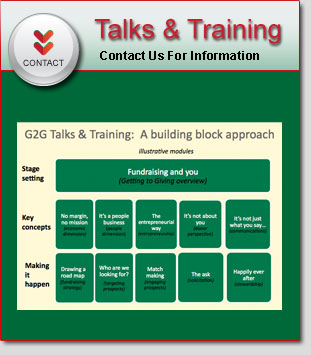Some months ago, we introduced the touchstone of our “big picture approach” to fundraising – entity planning – and promised to talk more about its four major steps. In our October newsletter, we spoke about how to develop a powerful mission statement.
The time has come to tackle the remaining three steps!
Now, we recognize that strategic planning and economic models aren’t – for many people – the sexiest of topics. So, we’ve decided to spice things up a bit, with a case study. (Yes, we also realize that case studies may not be considered the sexiest of things either, but that’s the best that these HBSers could come up with.)
We’ll start with some brief comments about each entity planning step and some overall considerations, and then share the story of a regional nonprofit land trust – Sudbury Valley Trustees (SVT).
Entity planning: Steps and tips
The entity planning process
Step 1. Define mission and goals
A quick reminder: your mission tells people what you’re all about… as the basis for why you want and merit a donor’s attention and money. It should be memorable, differentiable, credible, inspirational, aspirational, and simple. Think Rogers & Hammerstein (everyone can hum along to Oklahoma), not Andrew Lloyd Webber (Cats is wonderful but hard to sing!).
Step 2. Determine resources required
Next, you have to translate your organization’s mission and goals into a workable set of strategies and operational plans. The basic problem is that you’re not going to have the resources you need to accomplish everything you would like to do. So, like entrepreneurs, you can “dream big” but have to plan incrementally, and search for resources like talent or facilities. (Money is the ultimate fungible resource, of course.)
Here are a few tips:
- Make two lists: (1) things that are nice to have, and (2) things without which we’ll fail.
- Timing is critical, so look not just at what you need, but also when you will need it (i.e., what is required for current and expanded scale).
- Take a “snowball” approach that starts with an easy target, and tests the efficacy and scalability of your idea.
- Demonstrate your case, to attract more resources, and build the relationships, skills and experience needed for successful growth.
- Remember: your resource requirements will change. For a youth education program, operating a single location is very different from running a national network of organizations.
Step 3. Specify economics
Nonprofits tend not to understand the economics of their service models, for a variety of reasons: lack of financial expertise; a failure to appreciate the fundamentals; lack of discipline around cash flow, income statements, and balance sheets; absence of formal strategic or financial planning; a tendency to extrapolate from the past; and just plain not paying attention.
Your economic model must yield a “bottom line” that makes your mission financially viable. To accomplish that, you need to understand the nature of the service model that you’ve adopted.
Expenses are important, of course, and you must recognize that your cost structure will change as you evolve and grow. When I first became involved in land conservation, an acre of land in Southborough, MA cost $5,000; today it would cost $20,000.
Looking at the top line, you have three basic options: a philanthropic, membership, or earned income model. The trick is to adopt – and then adapt – a model (often with a mix of income sources) best suited for your enterprise. And, I would argue, fundraising should be your last – not first – resort.
Step 4. Identify financial sources and gaps
To continue that thought, think broadly and creatively about financial sources, including substitutes. Some examples: membership dues, service or product revenues, income from investments, grants, foundations, corporate sponsorships, volunteers, donated products, and – yes – individual giving.
A word to the wise: control and continuity are key issues for management, when thinking about ways to meet resource needs.
Many organizations tend to want to hire staff, but that loads on overhead. The more entrepreneurial approach is to ask yourself: “What do we absolutely need to control?” Odds are that you’ll end up with a list of things where a strategic partnership or some other approach would work just as well or better.
The key output of entity planning is an understanding of your unmet financial needs, as an input to setting fundraising goals. It’s an iterative process, of course. There is a back-and-forth relationship between entity planning and fundraising strategy development. And, inevitably, there will be new challenges and opportunities, some external and some internal.
Now, let’s take a look at one case example.
A case study: Sudbury Valley Trustees (SVT)
Mission
SVT is a regional nonprofit land trust that conserves land and protects wildlife habitat in the Concord, Assabet, and Sudbury river basin (in Massachusetts) for the benefit of present and future generations.
Scope
The Sudbury Valley encompasses 35 communities west of Boston with more than 650,000 residents, as well as non-resident employees of local firms. Founded in 1953, SVT is responsible for the protection and care of over 100 properties covering more than 3,600 acres of wetlands, sensitive habitats, trails and other open spaces. It manages 72 reservations (2,220 acres) acquired through purchase or gifts, which are open to the public free of charge for walking, bird watching, hiking, cross-country skiing and horseback riding. It also oversees 46 conservation restrictions (1,100 acres), and played a critical role in earmarking an additional 6,000 acres for permanent protection by public agencies.
Services
SVT pursues its land protection goals through land protection, land stewardship, advocacy and education. Land protection entails acquisition of properties of significant ecological or historical value, and requires close collaboration with landowners, other land trusts, and state and federal agencies. Stewardship involves ecosystem and habitat protection; maintenance of views, access and trails; protection of the legacy; and coordination of SVT’s volunteer stewardship program.
People
SVT accomplishes its work through a 17-member community board, a 9-person staff, and over 150 volunteers. Its approximately 3,000 members, who pay an annual fee of $40 (individuals) or $60 (families), receive a subscription to SVT’s newsletter, walking maps of properties, invitations to members-only events, and discount or free admission to SVT activities and outings. SVT collaborates with a network of partners to obtain specialized expertise (e.g., pro bono legal support, Environmental Protection Agency expertise), and collaborate on joint projects.
Economics
Memberships historically have been SVT’s dominant source of revenues for program and other operating expenses. For large acquisition projects, it solicits funds through fundraising campaigns. It also has established an endowment fund, annual and planned giving programs, and corporate sponsorships for major events. SVT’s financial reports consolidate results from four major components:
- Operations – Donations and revenues minus salaries, utilities, insurance, stewardship, administration, education, and cost of fundraising.
- Land transactions – Funds raised each year to preserve land minus the total cost of surveys, legal services, personnel, and SVT’s share of land parcel purchase costs. The year-to-year number is impacted by the timing of large land transactions (i.e., funds may be raised one year, and expended the next).
- Investments - Investment income and change in the value of SVT’s endowment.
- Other – Includes bequests, used for long term land projects.
Opportunities and challenges
SVT has significant opportunities to build on its success, including a variety of new projects. However, land costs have escalated even as the economy has dampened memberships and fundraising potential. As SVT grows, it also will strive to professionalize by undergoing a rigorous process for accreditation by the national Land Trust Alliance.
In conclusion, we hope that you’ve enjoyed and learned something from the SVT story. You’ll find more on it as well as other case studies in Getting to Giving!




